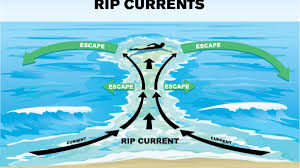Surviving Rip Currents: Essential Steps for Safety and Prevention
What to Do If You Get Caught in a Rip Current
Understanding Rip Currents

Understanding how to escape a rip current
Before diving into the steps to take if you find yourself caught in a rip current, it is crucial to understand what a rip current is. A rip current is a powerful, narrow channel of fast-moving water that can pull swimmers away from the shore. They are commonly found on beaches with breaking waves and can occur at any surf beach with the right conditions. Recognizing a rip current can be difficult, but signs include:
- A noticeable difference in water color, indicating deeper water.
- A line of foam, seaweed, or debris moving seaward.
- A break in the incoming wave pattern.
Steps to Take If You Are Caught in a Rip Current
- Stay Calm and Conserve Energy
The most critical step if you find yourself caught in a rip current is to stay calm. Panic can lead to exhaustion, making it harder to stay afloat and think clearly. Remember, rip currents do not pull swimmers underwater; they pull them away from the shore. By staying calm, you conserve energy, which is vital for your survival and escape.
- Do Not Fight the Current
One of the biggest mistakes swimmers make is trying to swim directly back to shore against the current. Rip currents can move at speeds of up to 8 feet per second, faster than even Olympic swimmers. Fighting the current will only lead to exhaustion. Instead, let the current carry you out until it weakens. Rip currents typically lose their strength a short distance from the shore.
- Float and Signal for Help
If you are unable to swim out of the rip current, float on your back to keep your head above water and conserve energy. While floating, wave your arms and call out for help to attract the attention of lifeguards or other beachgoers. By floating, you can stay safe until the current releases you or help arrives.
- Swim Parallel to the Shore
Once you feel the current’s pull weaken, start swimming parallel to the shore. Rip currents are usually narrow, often less than 100 feet wide, so swimming parallel to the shore for about 100 to 200 feet should take you out of the current. Once you are out of the current, you can then swim back to the shore at an angle away from the rip current.
- Wave for Assistance
If you find yourself too exhausted to swim, continue floating and signal for help. Waving one or both arms can help lifeguards or other beachgoers spot you. Lifeguards are trained to handle such situations, and many beaches have rescue equipment readily available.
Prevention and Safety Tips
While knowing what to do if you get caught in a rip current is essential, prevention is even better. Here are some safety tips to avoid getting caught in a rip current:
- Swim at Lifeguarded Beaches
Always choose to swim at beaches with lifeguards on duty. Lifeguarded beaches are monitored, and lifeguards are trained to recognize rip currents and rescue swimmers in distress.
- Observe Warning Signs and Flags
Pay attention to warning signs and flags posted at the beach. These indicators provide information about water conditions, including the presence of rip currents. Red flags typically indicate dangerous conditions, while yellow flags suggest caution.
- Learn to Recognize Rip Currents
Educate yourself on how to identify rip currents. Knowing what to look for can help you avoid entering the water where rip currents are present. Look for areas where waves aren’t breaking, water is choppy, or there’s a noticeable flow of water away from the shore.
- Swim with a Buddy
Never swim alone. Having a buddy increases your safety as you can watch out for each other and provide assistance if needed.
- Stay Within Your Swimming Ability
Only swim in areas where you feel comfortable and confident. If you are not a strong swimmer, stick to shallow waters where you can stand.
- Use Appropriate Flotation Devices
If you are not a strong swimmer, consider using a flotation device. Devices like life jackets can provide extra buoyancy and increase your chances of staying afloat if caught in a rip current.
- Stay Informed About Water Conditions
Before entering the water, check local weather and water conditions. This information is often available online or from local authorities.


Responding to Others in Rip Currents
If you see someone else caught in a rip current, do not attempt a direct rescue unless you are trained and have the appropriate equipment. Many rescuers drown each year while trying to save others. Instead, follow these steps:
- Alert a Lifeguard
Immediately notify a lifeguard if one is present. Lifeguards are trained to handle such situations and have the necessary equipment to perform rescues safely.
- Throw a Flotation Device
If a lifeguard is not available, throw a flotation device, such as a life jacket or a buoyant object, to the person in distress. This can help them stay afloat until help arrives.
- Call for Professional Help
Call emergency services and provide them with precise information about the situation and location. Professional rescuers can respond quickly and have the equipment needed for a safe rescue.
Conclusion
Rip currents are a natural and potentially dangerous phenomenon at many beaches. Understanding what to do if you get caught in one can save your life. The key steps are to stay calm, avoid fighting the current, float if necessary, and swim parallel to the shore once the current weakens. Prevention is equally important, including swimming at lifeguarded beaches, recognizing warning signs, and being aware of water conditions. By staying informed and prepared, you can enjoy the ocean safely and reduce the risks associated with rip currents.
